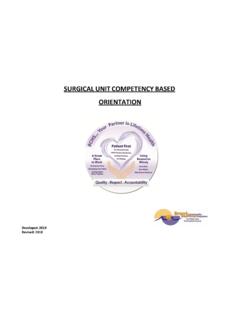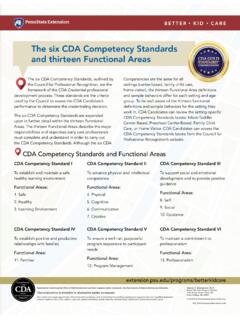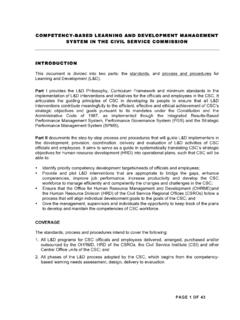Transcription of Competency-Based Training for Infection Prevention
1 Competency-Based Training for Infection Prevention 1. Presenter Shannon Davila, RN, MSN, CIC, CPHQ. Director of Institute for Quality and Patient Safety New Jersey Hospital Association Contributions by Marcia Cooke, DNP, RN-BC. American Hospital Association (AHA)/. Health Research & Educational Trust (HRET). Milisa Manojlovich, PhD, RN, CCRN. University of Michigan School of Nursing 2. Learning Objectives Define Competency-Based Training Describe the key components of a competency - based Training program for Infection Prevention 3. Improving Infection Prevention Practices 4. Definitions of competency The knowledge, skills, ability and behaviors that a person possesses in order to perform responsibilities correctly and skillfully.
2 The application of knowledge and the interpersonal, decision-making, and psychomotor skills expected for the practice role.. (O'Shea K, Hanley & Belfus, Inc., 2002; NCSBN Business Book Annual Meeting, NCSBN, 2005). 5. Essential Elements to Address All relevant healthcare personnel included in Training Training conducted upon hire and before provision of care or specific procedures At least annually and when new equipment or protocols are introduced Include specific elements of competency by domain Require healthcare personnel to demonstrate competency following each Training System of documentation of competency for each healthcare personnel 6. competency Assessment Initial or Core competency orientation Ongoing competency Annually or when new skills/knowledge is introduced Specialized competency Related to area of specialization such as device reprocessing, critical care, etc.
3 (Scott Tilley DD, J Contin Educ Nurs, 2008). 7. Different Roles: Different Competencies (Definition of Healthcare Personnel, CDC, 2014). 8. Role Specific competency Nursing Environmental Terminal Objective assistant services Describe the different types of microorganisms (bacteria, viruses, fungi, Yes Yes etc.), and their role in healthcare-associated infections. Describe antimicrobial resistance and its importance in healthcare-associated Yes Yes infections. Demonstrate proper techniques for collecting, handling and Yes No transporting of laboratory specimens. (Carrico R, Am J Infect Control, 2008). 9. Diverse Audiences Healthcare personnel represent many different roles, cultural backgrounds, age, levels of education and literacy Competency-Based Training programs must be designed to meet the needs of diverse group of learners 10.
4 Engaging the Adult Learner Adult Learners Strategies to Engage Adult Learners Focus on what they need to know Ensure a clear understanding of Set their own goals expectations Are aware of their current Mutually set goals knowledge Assess current knowledge before Possess a wealth of life teaching experiences Relate learning to past May lack confidence or experiences underestimate their own ability Sequence learning experiences to to learn (particularly if it is a new build confidence, then challenge skill) when comfortable May fear ridicule of peers Create safe environment for learning 11. Learners 10% of what is READ. 20% of what is HEARD. 30% of what is SEEN.
5 50% what is HEARD and SEEN. 80% of what is HEARD, SEEN and DONE. 12. Components of Competency-Based Training 13. Assessing Needs for Infection Prevention Training Regulatory: Meeting federal, state or accreditation requirements Organizational: orientation and annual, new products or policies and areas of risk Data driven: Targeted Assessment for Prevention (TAP) Strategy Individual needs: knowledge, skills and attitude (Gruppen L, University of Michigan, 2010; Miller GE, Academic Medicine, 1990). 14. Developing Content Identify the competencies of focus Define learning objectives Choose an instructional method Provide evidence- based content (O'Shea K, Hanley & Belfus, Inc.)
6 , 2002). 15. Delivering Content Emphasize mutual respect among learners and educators Consider ways to create an active learning environment Provide a comfortable setting that is conducive to the method of teaching 16. Assessing competency (Miller GE, Academic Medicine, 1990; Whelan L, Orthop Nurs, 2006). 17. Examples of Competency-Based Training Tools competency Training Tools CDC Targeted Assessment for Prevention (TAP) Strategy Implementation tools Hand hygiene and gloving Urinary catheter insertion and maintenance Environmental cleaning World Health Organization Hand hygiene Training kit 18. Summary Importance of Infection Prevention competency - based Training for healthcare personnel Adult learning principles and the diverse nature of the healthcare personnel as learners Components of Competency-Based Training Needs assessment Program design and delivery Competence assessment 19.
7 References 2016 National Patient Safety Goals. The Joint Commission. Available at Accessed on May 10, 2016. Business book: NCSBN 2005 annual meeting. Mission Possible: Building a Safer Nursing Workforce through Regulatory Excellence. National Council for State Boards of Nursing, NCSBN. 2005. Carrico R, Rebmann T, English JF, et al. Infection Prevention and control competencies for hospital- based healthcare personnel. Am J Infect Control. 2008; 36(10): 691 701. Colthart I, Bagnall G, Evans A, et al. The effectiveness of self-assessment on the identification of learner needs, learning activity, and impact on clinical practice: BEME Guide no. 10. Medical Teacher.
8 2008; 30(2): 124 145. Definition of healthcare personnel. Centers for Disease Control and Prevention . Available at Published April 2014. Accessed on May 15, 2016. Gruppen LD, Mangrulkar RS, Kolars JC. Competency-Based education in the health professions: Implications for improving global health. University of Michigan. Available at nce=1&isAllowed=y. Published 2010. Accessed on May 12, 2016. 20. References Hand Hygiene Starter Kit. World Health Organization. Available at Accessed on May 10, 2016. Infection Control Assessment and Response Tool. Centers for Disease Control and Prevention . Available at Accessed on June 29, 2016. Miller, GE. The assessment of clinical skills/competence/performance.
9 Academic Medicine. 1990; 65(9): S63-S67. O'Shea K. Staff Development Secrets, Questions and Answers Reveal the Secrets to Successful Staff Development. Hanley & Belfus, Inc. 2002. Partnering to Heal. Office of Disease Prevention and Health Promotion. Available at Accessed on May 21, 2016. Targeted Assessment for Prevention . Centers for Disease Control and Prevention . Available at Accessed on May 21, 2016. Tilley Scott, DD. competency in nursing: A concept analysis. J Contin Educ ;. 39(2):58-64. Whelan L. competency assessment of nursing staff. Orthop Nurs. 2006; 25(3):198-202. 21. THANK YOU! 22. Speaker Notes 23. Speaker Notes: Slide 1. Welcome to this module titled Competency-Based Training for Infection Prevention .
10 It is the first module of the competency - based Training , Audits and Feedback for Infection Prevention course. 24. Speaker Notes: Slide 2. This module was developed by national Infection Prevention experts devoted to improving patient safety and Infection Prevention efforts. 25. Speaker Notes: Slide 3. The objectives of this module are to define Competency-Based Training and to describe the key components to consider when designing Infection Prevention Training for healthcare personnel. 26. Speaker Notes: Slide 4. Competencies are the measurable or observable knowledge, skills and behaviors that one demonstrates as part of their job performance. In healthcare, our patients rely on healthcare personnel to be competent within their roles including role- specific Infection Prevention practices.

















